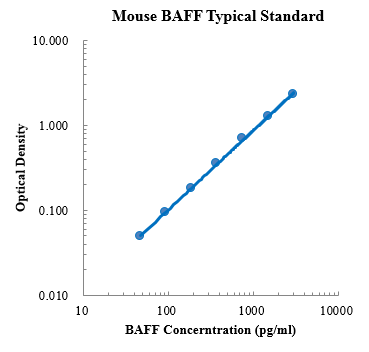
Mouse BAFF/BLyS/TNFSF13B ELISA Kit
$350.00 – $450.00
| Sample Type | Serum, plasma, cell culture supernatant, and other biological samples |
|---|---|
| Sample Volume | 100 μL(diluent) |
| Sensitivity | 3.15 pg/mL |
| Range | 46.88 pg/mL – 3000 pg/mL |
| Assay Time | 3.5 h |
| Recovery | 70% – 107% |
| Average Recovery | 1.02 |
| Intra Precision | 2.6% – 4.8% |
| Inter-Precision | 2.0% – 2.7% |
| Platform | ELISA |
| Plate | Detachable 96-well plate |
| Size | 96T/48T |
| Storage | If the reagent kit is unopened, it should be stored at 4℃. However, if it has been opened, the standard solution should be stored at -20℃, while the other components should be stored at 4℃. |
| Delivery | 4℃ blue ice transportation |
| Components | 96-well polystyrene enzyme-linked immunosorbent assay (ELISA) plate coated with anti-BAFF monoclonal antibody Human CD30 freeze-dried standard Angiotensinogen/AGT/ SerpinA8 detect Antibody Standard Diluent Assay Buffer(10×) Substrate TMB Stop Solution Washing Buffer(22×) Sealing Film |
| Assay Principle | This kit utilizes the double antibody sandwich enzyme-linked immunosorbent assay (ELISA) detection technique.Specific anti-鼠BAFF antibodies are precoated on a high-affinity ELISA plate. Standard samples, test samples, and the detection antibody labeled with horseradish peroxidase are added to the wells of the ELISA plate. After incubation, CD30 present in the samples binds to the solid-phase antibodies and the detection antibodies. After washing, a colorimetric substrate, TMB, is added and the plate is incubated in the dark for color development. The intensity of the color reaction is directly proportional to the concentration of CD30 in the samples. A stop solution is added to terminate the reaction, and the absorbance value is measured at a wavelength of 450 nm (with a reference wavelength range of 570-632 nm). |

Targets
TNFSF13B
TNFSF13B Target Infomation Overview
- Target Symbol: TNFSF13B, TNF superfamily member 13b
- Gene Groups: CD molecules; Tumor necrosis factor superfamily
- Alias: BAFF; THANK; BLYS; TALL-1; TALL1; CD257
- Previous Names: TNFSF20
- Alias Names: B-cell-activating factor; TNF and ApoL-related leukocyte expressed ligand 1; TNF homolog that activates apoptosis; B-lymphocyte stimulator; tumor necrosis factor (ligand) superfamily, member 13b
TNFSF13B, TNF superfamily member 13b Target Infomation by Species
Human TNFSF13B Target Information
- Target Symbol: TNFSF13B, TNF superfamily member 13b
- Alias:
- ApoL related ligand TALL-1
- b lymphocyte stimulator
- B-cell activating factor
- B-cell-activating factor
- B-lymphocyte stimulator
- BAFF
- BLYS
- CD257
- delta BAFF
- Delta4 BAFF
- dendritic cell-derived TNF-like molecule
- DTL
- TALL-1
- TALL1
- THANK
- TNF and ApoL-related leukocyte expressed ligand 1
- TNF homolog that activates apoptosis
- TNF- and APOL-related leukocyte expressed ligand 1
- TNFSF20
- TNLG7A
- tumor necrosis factor (ligand) superfamily member 13b
- tumor necrosis factor (ligand) superfamily, member 13b
- tumor necrosis factor (ligand) superfamily, member 20
- tumor necrosis factor ligand 7A
- tumor necrosis factor ligand superfamily member 13B
- tumor necrosis factor superfamily member 13b
- tumor necrosis factor superfamily, member 13b
- tumor necrosis factor-like protein ZTNF4
- ZTNF4
- NCBI_Gene: 10673
- UniProtKB: Q9Y275
Human TNFSF13B Predicted Functions
Predicted to enable receptor ligand activity. Involved in positive regulation of B cell proliferation. Located in several cellular components, including focal adhesion; perinuclear region of cytoplasm; and plasma membrane.
Mouse Tnfsf13b Target Information
- Target Symbol: Tnfsf13b, tumor necrosis factor (ligand) superfamily, member 13b
- Alias:
- BAFF
- BLyS
- D8Ertd387e
- DNA segment, Chr 8, ERATO Doi 387, expressed
- TALL-1
- zTNF4
- NCBI_Gene: 24099
Mouse Tnfsf13b Predicted Functions
Predicted to enable receptor ligand activity. Involved in B cell differentiation and tumor necrosis factor-mediated signaling pathway. Acts upstream of or within B cell homeostasis; positive regulation of germinal center formation; and positive regulation of lymphocyte activation. Predicted to be located in several cellular components, including focal adhesion; perinuclear region of cytoplasm; and plasma membrane. Predicted to be active in extracellular space. Is expressed in genitourinary system. Used to study IgA glomerulonephritis and Sjogren’s syndrome. Orthologous to human TNFSF13B (TNF superfamily member 13b).
Rat Tnfsf13b Target Information
- Target Symbol: Tnfsf13b, TNF superfamily member 13b
- Alias:
- B-cell-activating factor
- BAFF
- LOC498666
- RGD1561519
- similar to NZB B-cell activating factor
- Tnlg7a
- tumor necrosis factor (ligand) superfamily, member 13b
- tumor necrosis factor ligand 7a
- tumor necrosis factor ligand superfamily member 13B
- tumor necrosis factor superfamily member 13b
- NCBI_Gene: 498666
Rat Tnfsf13b Predicted Functions
Predicted to enable receptor ligand activity. Predicted to be involved in B cell differentiation; positive regulation of B cell proliferation; and tumor necrosis factor-mediated signaling pathway. Predicted to act upstream of or within B cell homeostasis; positive regulation of germinal center formation; and positive regulation of lymphocyte activation. Predicted to be located in several cellular components, including focal adhesion; perinuclear region of cytoplasm; and plasma membrane. Predicted to be active in extracellular space. Orthologous to human TNFSF13B (TNF superfamily member 13b).



